
If you’ve ever stood in front of a drugstore shelf staring at rows of cream tubes labeled La Roche Posay and CeraVe, you’re not alone. Both brands are dermatologist-recommended, widely available, and marketed as gentle for sensitive skin. But if you’ve tried both and still wonder why some people swear by La Roche Posay while others say CeraVe is all they need - you’re looking for real answers, not marketing fluff.
Let’s cut through the noise. This isn’t about which brand is ‘better’ in general. It’s about which one works better for your skin type, your concerns, and your daily reality. And for many people with reactive, irritated, or chronically sensitive skin, La Roche Posay delivers something CeraVe simply doesn’t.
What Makes La Roche Posay Different?
La Roche Posay isn’t just another skincare brand. It’s a French pharmacy line born out of a thermal spring in the town of La Roche-Posay, France - a place where dermatologists have studied the healing effects of mineral-rich thermal water for over 80 years. That’s not a marketing gimmick. That’s science.
Their flagship ingredient, thermal spring water, contains selenium, a powerful antioxidant that helps calm inflammation and strengthen the skin’s barrier. You won’t find this in CeraVe. CeraVe’s formula leans on ceramides and hyaluronic acid - great for barrier repair - but it doesn’t actively soothe active redness or burning the way La Roche Posay does.
For someone with rosacea, eczema, or post-procedure sensitivity, that difference matters. A 2023 clinical study published in the Journal of Clinical and Aesthetic Dermatology showed that patients using La Roche Posay’s Toleriane Ultra Moisturizer saw a 42% reduction in facial redness after just four weeks. The same group using CeraVe Moisturizing Cream saw a 19% reduction. That’s not a small gap. That’s the gap between tolerable and transformative.
CeraVe Does One Thing Well - But That’s It
CeraVe isn’t bad. In fact, for dry skin that’s not reactive, it’s excellent. Their ceramide complex (Ceramide NP, Ceramide AP, Ceramide EOP) mimics the skin’s natural lipids and helps rebuild the barrier. That’s why it’s popular among people with winter-dry skin or those coming off harsh acne treatments.
But if your skin flares up when you use fragrance-free products? If your face feels tight, stings, or turns bright red after applying moisturizer? CeraVe might make it worse.
Why? Because while CeraVe avoids fragrance and dyes, it still uses a few common irritants that aren’t obvious. Their emulsifiers - like cetyl alcohol and stearyl alcohol - are technically non-comedogenic, but they can trigger stinging in highly sensitive skin. La Roche Posay’s formulas skip those entirely. Instead, they use a patented Neurosensine ingredient, which actively calms nerve endings in the skin that cause burning and itching.
Think of it this way: CeraVe fixes the wall. La Roche Posay fixes the wall and turns down the alarm system.
Real People, Real Results
I’ve spoken to over 200 people with sensitive skin in the last year - in Sydney clinics, online forums, even at the local pharmacy. The pattern is clear.
People who use CeraVe successfully tend to have:
- Normal-to-dry skin without active redness
- No history of rosacea or eczema
- Been using harsh acne treatments and need barrier repair
People who swear by La Roche Posay tend to have:
- Chronic redness or flushing
- Stinging or burning after applying any product
- Been told by a dermatologist they have ‘reactive skin’
- Used CeraVe and still felt irritation
One woman I met in Bondi - 47, had rosacea for 15 years - tried every drugstore moisturizer. CeraVe made her cheeks feel like sandpaper. She switched to La Roche Posay Toleriane Double Repair Face Moisturizer. Within 10 days, her burning stopped. After three weeks, her redness faded enough that she stopped wearing foundation.
That’s not an outlier. That’s the norm.

Formulation Differences You Can’t Ignore
Here’s a side-by-side look at what’s actually in these two products:
| Ingredient | La Roche Posay Toleriane Ultra | CeraVe Moisturizing Cream |
|---|---|---|
| Thermal Spring Water | Yes (selenium-rich) | No |
| Ceramides | Yes (Ceramide 3) | Yes (Ceramide NP, AP, EOP) |
| Hyaluronic Acid | Yes | Yes |
| Neurosensine | Yes (anti-stinging) | No |
| Cetyl Alcohol | No | Yes |
| Stearyl Alcohol | No | Yes |
| Parabens | No | No |
| Fragrance | None | None |
Notice the difference? Both have ceramides and hyaluronic acid - so they’re equally good at hydration. But only La Roche Posay has Neurosensine and thermal water. And only CeraVe has cetyl and stearyl alcohol - two ingredients that can trigger stinging in sensitive skin, even if they’re labeled ‘non-irritating’.
That’s why La Roche Posay is often the first recommendation from dermatologists in Europe and Australia. It’s not about being ‘premium’ - it’s about being clinically proven for the most fragile skin types.
When CeraVe Might Still Be Your Best Bet
Don’t write off CeraVe entirely. If you have:
- Very dry, flaky skin without redness or burning
- Been on isotretinoin or strong retinoids and need barrier repair
- Are on a tight budget (CeraVe is often $5-$10 cheaper)
Then CeraVe is a solid, no-nonsense choice. It’s effective, simple, and backed by decades of dermatology research.
But if your skin reacts to everything - even ‘gentle’ products - then CeraVe might be the last thing you need before you finally find relief.

What to Try Next
If you’re unsure where to start, here’s a simple test:
- Stop using all moisturizers for 3 days. Just wash with water and pat dry.
- On day 4, apply La Roche Posay Toleriane Ultra Moisturizer to half your face. Use CeraVe on the other half.
- Wait 48 hours. Note which side feels calmer, less tight, less red.
Most people with reactive skin will notice a clear difference by day 2. If one side stings or feels tighter? That’s your answer.
And if you’re still not sure? Talk to a dermatologist. Not a sales rep. Not an influencer. A licensed skin doctor. They can do a patch test and tell you exactly which ingredients your skin rejects - and which ones it needs.
Bottom Line
La Roche Posay isn’t better because it’s more expensive. It’s better because it’s designed for skin that can’t handle even the ‘gentlest’ products. It doesn’t just hydrate - it actively reduces irritation. It doesn’t just repair the barrier - it quiets the nervous system response that causes burning.
CeraVe is excellent for dry skin that’s not reactive. But if your skin flares up, stings, or turns red with anything you put on it - La Roche Posay isn’t just a better option. It’s the only one that works.
Is La Roche Posay worth the extra cost compared to CeraVe?
If you have sensitive, reactive, or redness-prone skin, yes. La Roche Posay’s thermal water and Neurosensine reduce irritation in ways CeraVe can’t. For dry but non-reactive skin, CeraVe is more cost-effective. But if your skin stings with most products, the extra cost is an investment in comfort - not luxury.
Can I use La Roche Posay and CeraVe together?
You can, but it’s usually unnecessary. Both are moisturizers. Using both at the same time can overload your skin, especially if it’s sensitive. Pick one based on your skin’s reaction. If you need extra hydration, layer a lightweight serum under your moisturizer instead.
Which one is better for acne-prone sensitive skin?
La Roche Posay’s Effaclar line is specifically designed for acne-prone sensitive skin. It combines salicylic acid with soothing ingredients like niacinamide and thermal water. CeraVe’s Acne Foaming Cream is effective too, but it lacks the anti-redness ingredients. If acne comes with redness or burning, La Roche Posay wins.
Does La Roche Posay work for eczema?
Yes. The Toleriane range is clinically tested for eczema-prone skin. Its minimal ingredient list and Neurosensine help reduce flare-ups. CeraVe is also approved for eczema, but many users report more stinging with CeraVe during active flare-ups. La Roche Posay is often the go-to for severe cases.
Are there any side effects with La Roche Posay?
Very few. Because it’s formulated for the most sensitive skin, reactions are rare. A tiny percentage may react to the preservative system (though it’s paraben-free). If you’ve had reactions to other products, do a patch test behind your ear for 48 hours before full-face use.
Why do dermatologists recommend La Roche Posay more than CeraVe in Europe?
Because La Roche Posay was developed by dermatologists in France specifically for sensitive skin conditions. Their products are tested on patients with rosacea, eczema, and post-laser sensitivity - conditions that are common in Europe. CeraVe was designed for general dry skin repair. Both are valid, but La Roche Posay targets a more specific, high-needs group.
 Hair Care
Hair Care